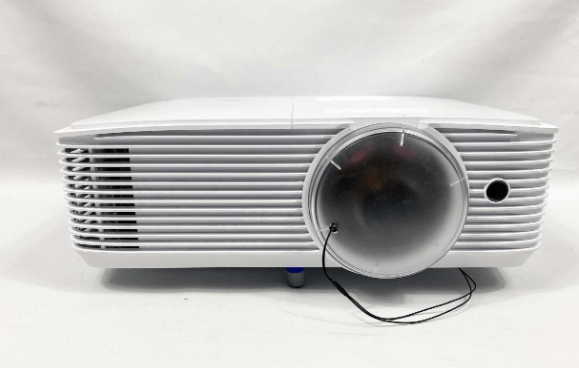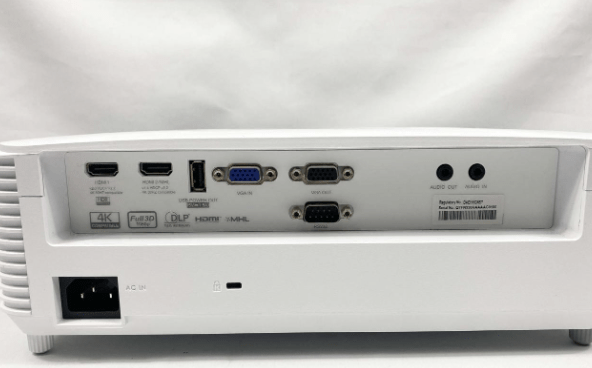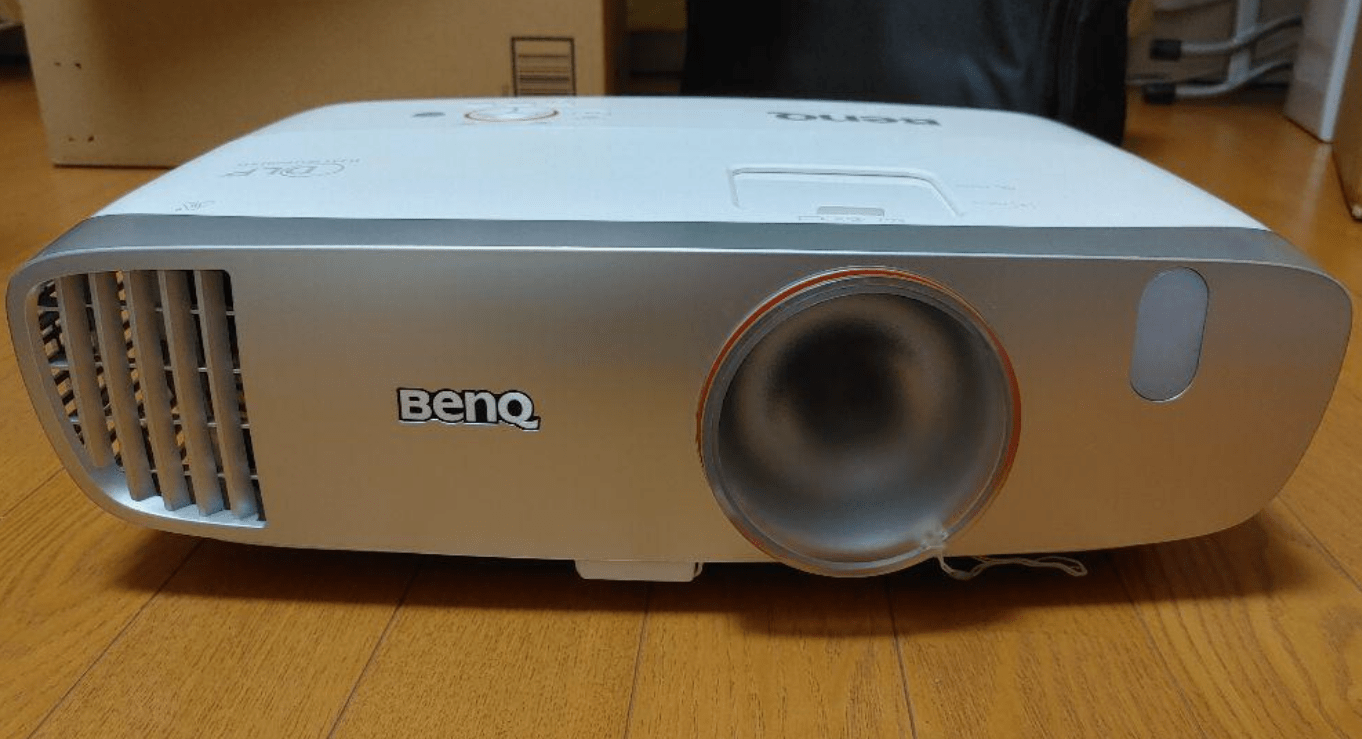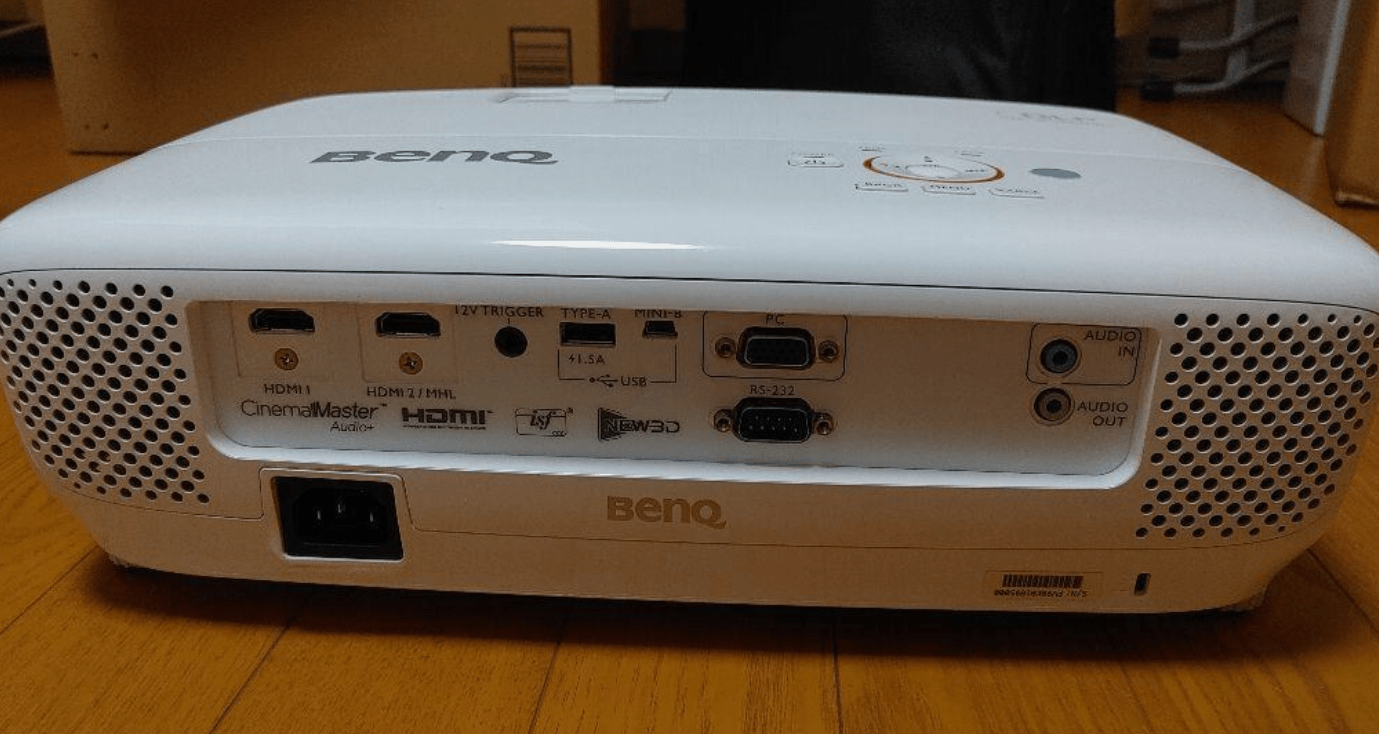At gagadget.com, your trust is our priority. We follow strict quality standards in our research, tests, and analysis of video projectors, to give you the best experience. Learn more
Optoma GT1080HDR vs Benq HT2150ST
Hello everyone, it's Jim from Gagadget. Today I'm pitting two formidable short throw gaming projectors against each other: the Optoma GT1080HDR and BenQ HT2150ST. Both are designed to deliver big screen thrills from just a few feet away, with low input lag, high brightness, and specialized gaming modes. But they also have some key differences in performance, features, and overall value.
I've spent many hours hands-on with both projectors, scrutinizing image quality, measuring response times, tweaking the settings, and of course, fragging baddies on 100"+ screens. In this in-depth GT1080HDR vs HT2150ST showdown, I'll break down how they compare in the categories that matter most to gamers. Let's get ready to rumble!
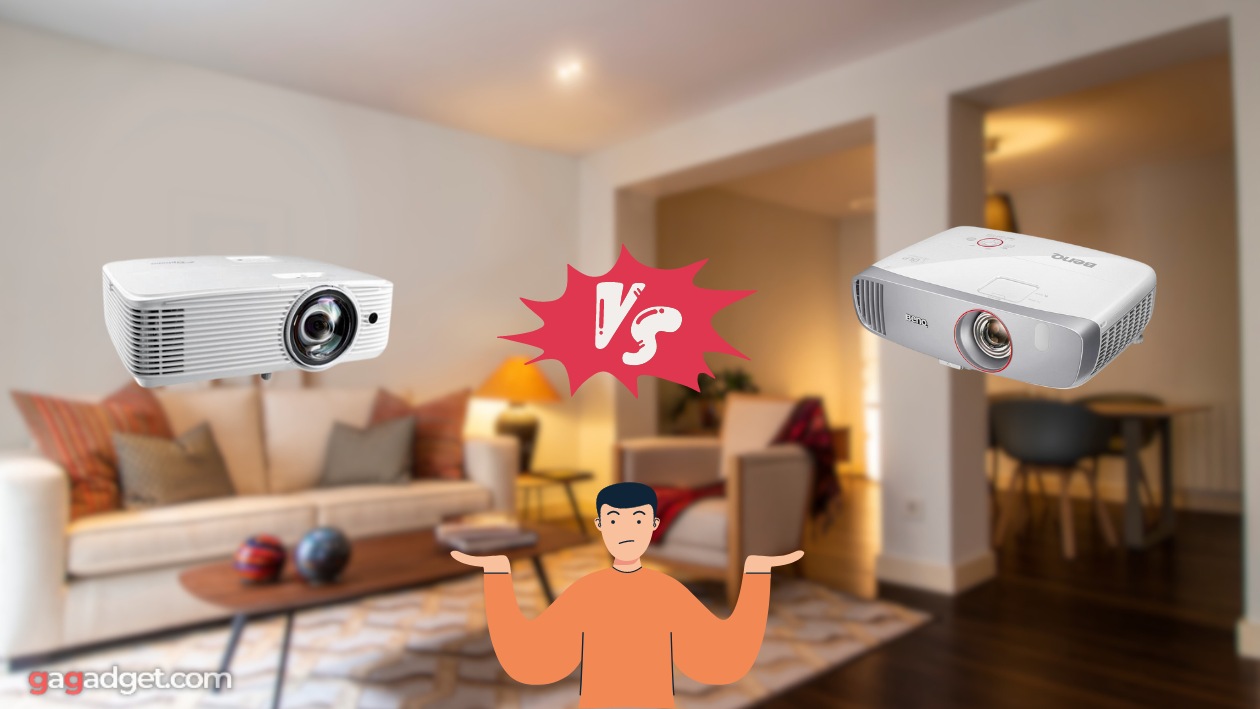
Optoma GT1080HDR vs BenQ HT2150ST: Quick Overview
I respect your time and aim to provide only the essential information, skipping the fluff.
Here's a brief summary for those short on time: The Optoma GT1080HDR and BenQ HT2150ST are both single-chip DLP projectors with Full HD 1080p resolution and short throw ratios under 1:1. They offer low input lag (under 17ms), high brightness (2,200-3,800 lumens), and gaming-specific picture modes. The main differences are that the GT1080HDR supports 4K HDR input and 120Hz refresh rate, while the HT2150ST has a slightly shorter throw and better contrast. The Optoma is also brighter and newer overall.
For most gamers, I give the edge to the Optoma GT1080HDR. The higher 3,800 lumen output, HDR compatibility, and 120Hz mode provide a noticeable competitive advantage, especially in rooms with ambient light. But if you game in a darker space and value contrast over raw brightness, the BenQ HT2150ST is an excellent and potentially better value alternative.
Table of Contents
- Optoma GT1080HDR vs BenQ HT2150ST: Full Comparison
- HT2150ST vs GT1080HDR: Design
- Optoma GT1080HDR or BenQ HT2150ST: User Reviews
- GT1080HDR and HT2150ST Alternatives
- Optoma GT1080HDR or BenQ HT2150ST: Which Short Throw Projector is Best?
Optoma GT1080HDR vs BenQ HT2150ST: Full Comparison
| Specs | Optoma GT1080HDR | BenQ HT2150ST |
| Image |
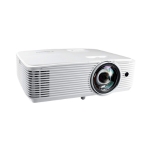
|

|
| Resolution | 1920 x 1080 (Full HD) | 1920 x 1080 (Full HD) |
| Brightness (Lumens) | 3,800 ANSI | 2,200 ANSI |
| Contrast Ratio (Dynamic) | 50,000:1 | 15,000:1 |
| Display Tech | 0.65" 1080p DLP | 0.65" 1080p DLP |
| Input Lag | 8.4ms @ 1080p/120Hz | 16ms @ 1080p/60Hz | 32ms @ 4K/60Hz | 16.67ms @ 1080p/60Hz |
| Max Refresh Rate | 120Hz @ 1080p | 60Hz |
| Throw Ratio | 0.50:1 | 0.69-0.83:1 |
| Image Size | 36" - 306" | 60" - 300" |
| HDR Compatibility | HDR10/HLG (4K input) | No |
| Zoom | Fixed (Digital only) | 1.2x Manual |
| Keystone Correction | Vertical only | Vertical only |
| Lamp Life (Normal/Eco) | 4,000/15,000 hours | 3,500/7,000 hours |
| Integrated Speakers | 10W mono | 20W mono w/ audio enhancer |
| Connectivity | 2x HDMI (1x 4K/HDCP 2.2), VGA in/out, 3.5mm audio in/out, USB-A, RS-232C | 2x HDMI (1x MHL), VGA, 3.5mm audio in/out, 2x USB-A, RS-232C, 12V trigger |
| Dimensions (W x D x H) | 12.4" x 9.5" x 4.3" | 15.0" x 11.1" x 4.8" |
| Weight | 7.7 lbs | 7.9 lbs |
| Release Year | 2019 | 2016 |
Right off the bat, the Optoma GT1080HDR pulls ahead with its higher brightness. At 3,800 ANSI lumens, it's over 70% brighter than the BenQ HT2150ST's 2,200 lumens. In my experience, this made a huge difference for daytime gaming or in rooms with uncontrolled ambient light. The Optoma maintained a much punchier, more saturated picture that was easier on the eyes. I could game longer without fatigue.
Both projectors use a 0.65-inch 1080p DLP chip with a 6-segment RGBRGB color wheel for similar sharpness and color. But the GT1080HDR expands compatibility with consoles and PCs by accepting 4K input signals. It can't display a true 4K image, but it can downscale 4K content to 1080p while preserving HDR10/HLG metadata. This is huge for PS4 Pro, Xbox One X, and 4K-capable gaming PCs.
The HT2150ST maxes out at 1080p60 input with no HDR support. It still looks great, but you won't get those extra pixels or extended dynamic range. I did find the BenQ's out-of-box color accuracy to be a touch better, with more natural skin tones and richer reds. But after some tweaking, the Optoma wasn't far behind.
For hardcore gamers, the GT1080HDR's headlining feature is the Enhanced Gaming Mode with a 120Hz refresh rate and 8.4ms input lag. This is a massive upgrade over the standard 60Hz/16ms performance, delivering much smoother motion and near-instant response. It's a game-changer for fast-paced shooters or fighting games where every frame counts.
The HT2150ST tops out at 1080p60 with 16.67ms lag. While still very good for a projector, it can't match the Optoma's 120Hz fluidity. I definitely noticed more judder and slightly mushier controls in titles like Call of Duty and Street Fighter V. The BenQ is no slouch, but the GT1080HDR has a clear competitive edge.
One area where the HT2150ST fights back is contrast - 15,000:1 dynamic vs the GT1080HDR's 50,000:1. While a higher number might seem better, the Optoma's contrast is inflated by a dynamic iris that's constantly adjusting the image. The BenQ's native contrast and black levels were noticeably inkier in a dark room, revealing more shadow detail.
The HT2150ST also has a slightly shorter throw ratio of 0.69-0.83 vs the GT1080HDR's 0.50. This means it can cast a larger image from the same distance - 100 inches from just 5.5 feet vs 6.6 feet for the Optoma. Not a huge gap, but potentially useful for small rooms or coffee table setups.
Other notable extras on the BenQ include the 1.2x manual zoom (the Optoma is fixed), bigger 20W speaker with audio enhancement, and more robust connectivity with MHL and a 12V trigger for motorized screens. The Optoma counters with a smaller chassis, lighter weight, and much longer max lamp life of 15,000 hours (4,000 hours on the BenQ).
HT2150ST vs GT1080HDR: Design
Design-wise, the Optoma GT1080HDR and BenQ HT2150ST have a very similar aesthetic - boxy white chassis with rounded edges and large, centrally-placed lenses. Both have rear-facing input panels and side/top ventilation to exhaust heat. The Optoma is slightly more compact overall.
Optoma GT1080HDR Design:
BenQ HT2150ST Design:
The GT1080HDR measures 12.4 x 9.5 x 4.3 inches (W x D x H) and weighs 7.7 pounds. The HT2150ST is a touch larger and heavier at 15.0 x 11.1 x 4.8 inches and 7.9 pounds. Neither is a true portable in the vein of pico or palmtop models. But they're fairly easy to move between rooms or take to a friend's place for game night.
Placement flexibility is similar between the two. The Optoma's 0.50:1 throw and fixed lens mean you'll need to be precise with distance from the screen. The BenQ's 0.69-0.83:1 throw and 1.2x zoom give you a bit more wiggle room, both in initial setup and if you decide to adjust screen size down the line.
On the back panel, the GT1080HDR provides dual HDMI inputs (one with HDMI 2.0/HDCP 2.2 for 4K sources), VGA in/out, 3.5mm audio in/out, RS-232C for automation systems, and a USB-A port for power or firmware updates. The HT2150ST is nearly identical but swaps one HDMI for MHL, adds a second USB, and includes a 12V trigger.
The remotes are fairly standard IR affair, with the Optoma's having a slight edge in backlight and dedicated input/picture buttons. Neither is a standout but both get the job done. I do wish the BenQ had a lens shift dial or keystone buttons on the chassis for quicker initial setup.
Optoma GT1080HDR or BenQ HT2150ST: User Reviews
So what are actual buyers saying about their experiences with the GT1080HDR and HT2150ST? Here's a sampling of impressions from across the web:
Optoma GT1080HDR User Impressions:
Praises: "The 120Hz mode is incredible for fast-twitch shooters. I never realized how much smoother FPS games could be on the big screen. It's hard to go back to 60Hz!"
"The short throw is a godsend for my cramped game room. I'm getting a 100"+ screen from just a few feet away with no visible pixels or screen-door effect."
***
Drawbacks: "Black levels are on the weak side, even with Dynamic Black enabled. Dark scenes in horror games can look a bit washed out and flat."
"The input lag isn't as low as advertised for 4K60 content - I measured closer to 35-40ms. Still very playable but not the 16ms claimed."
BenQ HT2150ST User Impressions:
Praises: "The contrast and color accuracy are phenomenal out of the box. Gears 5 and Red Dead 2 look incredibly rich and cinematic, no tweaking needed."
"The 1.2x zoom and wide throw ratio made it super easy to fit my 120" screen - I just set it on a stool and lined it up in 2 minutes flat."
***
Drawbacks: "The 60Hz refresh rate and 17ms lag are fine for RPGs and fighting games but I definitely notice mild blur & stutter in fast-paced shooters."
"Fan noise is a bit louder than I'd like, especially in non-eco lamp mode. It's a steady whoosh that you can hear during quiet moments."
Overall, GT1080HDR owners rave about the 120Hz smoothness, 4K/HDR input, and ultra-short throw for big images in tight spaces. Some complaints about mediocre black levels and optimistic input lag claims, but still highly recommended by most buyers.
HT2150ST users praise the excellent out-of-box color accuracy, strong contrast, and easy placement flexibility. A few gripes about the 60Hz limit and audible fan, but the vast majority feel it's an outstanding value for the price, especially for video games.
GT1080HDR and HT2150ST Alternatives
If you're not sold on the GT1080HDR or HT2150ST, here are a couple other short throw gaming projectors worth a look:
- Optoma HD39HDR: A brighter (4000 lumens), higher-contrast (50,000:1) alternative to the GT1080HDR in a standard throw with similar gaming specs - great if you have more space;
- BenQ HT2050A: A newer 2200-lumen, 1080p DLP projector with better out-of-box color accuracy than the HT2150ST but slightly higher lag (16ms).
The Optoma HD39HDR is a nice step up from the GT1080HDR if you don't need the ultra-short throw. You get a longer 1.3x zoom, bigger 15W speakers, higher 4000 lumen output and 500,000:1 claimed contrast ratio. It has the same 120Hz and 8ms response time at 1080p and 4K60 input. Just know that you'll need about 9-13 feet of throw distance for a 100-130" screen.
In the BenQ camp, the newer HT2050A offers largely similar performance as the HT2150ST. You still get 1080p resolution, 2200 lumens, 15,000:1 contrast, and a 6x RGBRGB color wheel. But it uses BenQ's latest CinematicColor tech for 96% Rec.709 coverage and improved tone mapping. Input lag is a bit higher at 16ms and there's no short throw, but it's a great choice under $1000.
Optoma GT1080HDR or BenQ HT2150ST: Which Short Throw Projector is Best?
When the dust settles, it's clear that both the Optoma GT1080HDR vs BenQ HT2150ST are exceptional gaming projectors that provide a level of speed and immersion far beyond your average TV. With input lag under 17ms, high brightness, short throw optics, and gaming-centric features, they check all the boxes for a responsive, room-filling experience. You really can't go wrong with either for big screen gaming bliss.
That said, if you pressed me to choose, I'd give the overall edge to the Optoma GT1080HDR. The 120Hz refresh rate and 8.4ms response time at 1080p make a palpable difference in fast-paced games where every millisecond counts. Combine that with the higher 3800 lumen output, full 4K HDR input support, and slightly shorter throw distance, and it's simply the more capable and future-proof gaming machine. Yes, you pay a bit more, but I think it's worth it for discerning players.
The BenQ HT2150ST remains an outstanding value, however - especially if you mostly play single-player games or slower-paced genres where the 60Hz limit isn't a dealbreaker. It bests the Optoma in native contrast, out-of-box color accuracy, optical zoom flexibility, and all-around bang for the buck. If you can live without 4K input and don't need the absolute lowest lag, the HT2150ST will serve you very well for years to come.
Regardless of which model you choose, prepare to be blown away when you fire up your favorite titles. Modern games offer unparalleled artistry and immersion, and experiencing them at display sizes north of 100" never gets old. With a projector, your living room becomes a portal to limitless adventures and digital worlds. The only question is - can you handle the adrenaline rush?
If you found this article useful, I'd really appreciate you giving it a share on your favorite social media or gaming forums. The more gamers we can reach, the better!
Go Deeper:
